Christine Valters Paintner's Blog, page 50
October 30, 2021
Monk in the World Video Podcasts (Sabbath)
Dearest monks, artists, and pilgrims,
I am delighted to share the next in our Monk in the World Video Podcast series – morning and evening prayer exploring the principle of Sabbath. Sabbath is a contemplative practice found in Christianity, Judaism, and Islam. It is also at the heart of a yoga practice when we rest into “corpse pose” at the end and allow everything to integrate. Cultivating this rhythm of rest in our lives is part of our commitment to relishing joy.
The following reflection is excerpted from Imam Jamal Rahman’s recent co-authored book The Teachers of Spiritual Wisdom: Gaining Perspective on Life’s Perplexing Questions published by Wipf and Stock
Sufis rhapsodize over this astonishing revelation that came to the Prophet Muhammad in a dream:
“I was a secret Treasure and I longed to be know.And so I created you, and the worlds, visible and invisible.”
Cosmically encoded within us is a deep and mysterious longing to know and connect with our Creator. Within every desire for anything in our lives is a yearning for our Beloved. The inexplicable unease we experience in our life even when our wants are fulfilled is expressed in the utterance of the beloved 8th century female Islamic saint Rabia: “There is a disease in my breast no doctor can cure; only union with the Friend can cure this.”
The Qur’an says that our Creator is within and without. To connect with Allah inside of us, we have to do the essential inner work of evolving into the fullness of our being by removing the veils of our ego so that we move closer to our higher self. This work is critical. Sufi teachers explain with a metaphor: A benevolent King sends you to a faraway country with a specific task. You go there and do many beautiful things but not that one specific task. Upon your return, can you say that you have attained?
To bond with Divinity outside of us, we experience the joy of serving God’s creation. We strive, in the words of the 13th century sage Rumi to be a “lamp, lifeboat or ladder” to others. The 20th century Indian poet Tagore wrote, “I slept and dreamt that life was joy; I awoke and found that life was service; I served and lo! Service was joy!”
May the words of the Prophet Muhammad splash in your heart: “When you arrived here, everyone was laughing and smiling but you were crying and weeping. Live such a life that when you depart, everyone is crying and weeping but you are laughing and smiling.”
Be sure to join us next Saturday, November 6th when we joyfully welcome Jamal. He will be leading us in a mini-retreat on the Sufi mystics. If Rumi and Hafiz make your heart tremble with joyful knowing – or you long to cultivate that kind of desire for the Beloved in your life – you will definitely want to join us.
With great and growing love,
ChristineChristine Valters Paintner, PhD, REACE
The post Monk in the World Video Podcasts (Sabbath) appeared first on Abbey of the Arts.
October 26, 2021
Monk in the World Guest Post: Nancy Agneberg
I am delighted to share another beautiful submission to the Monk in the World guest post series from the community. Read on for Nancy Agneberg’s reflection “Contemplative Driving: Noticing, Wondering, Returning.”
Although my father’s death was not unexpected—after all, he was 96 years old, I miss him. A lot
During the eight weeks of Dad’s dying, I drove the same round trip every day. Thirteen miles in the morning and then again later in the day. My destination was my widower father’s home where he had lived easily and contentedly for several years. Even though I wasn’t walking the Camino de Santiago, spending nights in hostels along the way, rubbing my feet with lotions to ease the blisters from too many miles and too tight boots, I was still a pilgrim. A pilgrim driving in her blue Jeep.
Most days I traveled alone, not exchanging trials and triumphs with other pilgrims encountered along the way. Sometimes I listened to public radio, welcoming the familiar voices of people I’ve never met, but most of the time I drove in contemplative silence.
In her book, Water, Wind, Earth and Fire, The Christian Practice of Praying with the Elements, Christine Valters Paintner describes contemplative walking as a time for noticing, wondering, and returning. (120). And that’s exactly what I did, only instead of walking, I practiced contemplative driving.
When I first started making the daily pilgrimage to Dad’s apartment, the trees were bare and the ground, brown. Occasionally, I drove through a snow squall, winter blowing its last breath. My route along Minnehaha Creek was still covered with ice, and the runners and dogwalkers were bundled tightly in winter gear. As the weeks passed, however, I noticed fewer dried and prickly Christmas wreaths on front doors, and lifeless pots of Christmas greens on front steps were replaced with jaunty pansies. A soft green haze developed on the trees along the parkway, and I felt the promise of spring as buds formed. Eventually, crabapple and lilac trees burst into full, fluffy bloom. Day by day.
Along with every variety of dog, I spotted wild turkeys strutting their stuff, and one day, much to my surprise and delight, I saw a parrot perched on the back of a bike, seemingly enjoying the fresh air and the change of scenery, as its owner coasted along city blocks. What was that story? And what about the tired-looking older woman I noticed leaning on her walker most every morning at a bus stop? Where was she going?
I passed the bandshell at Minnehaha Park not far from the falls Henry Wadsworth Longfellow made famous with his poem “The Song of Hiawatha.” I wondered if my husband and I would in the coming summer months enjoy a picnic in the park before attending a concert, as we had many times before. Those were the early days of the pandemic, days of shelter in place, and I passed empty church parking lots and school playgrounds. What was everyone doing and how were they managing?
I sent blessings, “Be safe,” to those who lived in the homes I passed, thinking surely we should know each other because I had passed by so often. Sometimes I played a game with myself, noting the houses that most appealed me, imagining what it would be like to live there.
Crossing the bridge over the Mississippi River connecting St Paul and Minneapolis, I often saw an eagle soaring, a reminder to whisper my mantra, “May I know and be the presence.” I repeated it and took a deep cleansing breath at STOP signs and at familiar landmarks – the bakery that made my wedding cake decades earlier, the funeral home where my mother’s body was taken after she died so long ago, the location where there used to be a Dairy Queen and is now a bank.
Most days the trip took 25-30 minutes, depending on the number of green lights. It could have been less if I had driven the highway, but I needed the time to prepare myself before arriving at the newly-designated sacred destination. Each time I wondered before getting out of the car, if that would be the day my beloved father would take his last breath.
And then hours later, when I retraced my route, returning to our house, I wondered if tomorrow I would not sit by his bedside again. Had I told him I loved him and heard him tell me he loved me, too, for the last time? Sometimes after pulling into the garage, I remained in the car, my sanctuary, for a few minutes, crying, even sobbing, before heading into the house.
Those daily drives were a spiritual practice: contemplative driving.
I noticed my feelings and what supported and strengthened and nurtured me.
I wondered in what ways I would continue to experience Dad’s presence.
I returned to calm, amidst my sadness and loss.
And I prayed, mile after mile, “May I know and be the presence.”

Nancy L. Agneberg is living her Sacred Seventies fully and gratefully in her many roles, including mother, grandmother, spouse, friend, writer, spiritual director, hometender, volunteer, voracious reader, walker of labyrinths. Read her perspectives on aging as a spiritual director on her LivingOnLifesLabytinth.com or ClearingtheSpace.blogspot.com
The post Monk in the World Guest Post: Nancy Agneberg appeared first on Abbey of the Arts.
October 25, 2021
Breath Prayer Book Launch Recording Available
I was delighted to be joined by Simon de Voil and Jamie Marich to celebrate the launch of my latest book, Breath Prayer: An Ancient Practice for the Everyday Sacred. We gathered with many of you to share song and movement and breath as a way to deepen into this practice.
I invite you to join us for the Advent Breath Prayer Retreat: A Companion to the Book which begins November 29th.
The post Breath Prayer Book Launch Recording Available appeared first on Abbey of the Arts.
October 23, 2021
Monk in the World Video Podcasts (Work)
Dearest monks, artists, and pilgrims,
We have our newest Monk in the World Prayer Cycle video podcasts available for you this week on the principle of meaningful work. Follow the links above for morning and evening prayer.
I am also hosting a book launch tomorrow (October 25th) for my newest book Breath Prayer: An Ancient Practice for the Everyday Sacred. I will be joined by Simon de Voil who will be offering his gift of music and Jamie Marich who will lead us in a short dancing mindfulness practice connected to breath. I will be talking about the roots of breath prayer and leading us in a practice of creating our own breath prayer to draw on throughout the days to come. This is a free event and there will even be a chance to win a space in our Advent companion retreat to the book for those who join us live. If you can’t join live, we will be recording the session.
This is one of my favorite times of year as we approach the Celtic feast of Samhain and All Saints/Souls. Samhain marks one of the two great doorways of the Celtic year. The Celts divided the year into two seasons: the season of light and the season of dark. Some believe that Samhain was the more important festival, marking the beginning of a whole new cycle, just as the Celtic day began the previous night. In the silence of darkness comes the whisperings of new beginnings.
Two significant features of this feast are the beginning of the season of darkness and the honoring of ancestors. Crossing the threshold means welcoming in the dark as a time of becoming more closely woven with the spiritual dimension of life. Winter invites us to gather inside, grow still with the landscape, and listen for the voices we may not hear during other times of year. These may be the sounds of our own inner wisdom or the voices of those who came before us.
The Celtic feast coincides with the Christian celebration of All Saint’s Day on November 1st and All Soul’s Day on November 2nd which begin a whole month in honor of those who have died. We tend to neglect our ancestral heritage in our culture, but in other cultures remembering the ancestors is an intuitive and essential way of beginning anything new. We don’t recognize the tremendous wisdom we can draw upon from those who have traveled the journey before us and whose DNA we carry in every fiber of our bodies. We carry not just their wounds but also their resilience and courage as well.
This is one of my favorite times of year with the darkening days of autumn and the spreading color across the trees. I have long loved the wisdom of the Celtic Wheel of the Year, but living here in Ireland I experience the turning points more keenly.
In the ancient Celtic imagination, this was considered to be a “thin time” when the veil between heaven and earth grew more transparent and the wisdom of our ancestors was closer to us. We are reassured that we are not alone, that we share the world with a great “cloud of witnesses” and “communion of saints” just across the veil. This season is a threshold space and in thresholds we are closer to the other world which is always here. The communal honoring of the dead continues for the whole month of November.
We have three ways to support you in deepening into this season: Yoga with Melinda: Samhain, a mini-retreat with Christine on Writing with the Ancestors, and a Contemplative Prayer Service with Christine and Simon. We hope you will join us for one or all of these programs as a way of receiving the love of thousands who stand beyond the veil.
With great and growing love,
ChristineChristine Valters Paintner, PhD, REACE
The post Monk in the World Video Podcasts (Work) appeared first on Abbey of the Arts.
October 19, 2021
Monk in the World Guest Post: Robert Walk
I am delighted to share another beautiful submission to our Monk in the World guest post series from the community. Read on for Robert Walk’s reflection “Do Dancing Monks Retire?”
One of our monk manifesto principles is that of silence. Silence is an attribute I come by naturally. Silence as in quiet, particularly in a group, be it in family gatherings or otherwise. However, being quiet or silent as a personality trait does not equate to the practice of silence that defines part of our “monkdom” qualities, although it may contribute to its development.
For fifty-three years I have participated in professional ministry both as a local pastor in the American Baptist tradition and as a Chaplain in an interfaith setting. While silence and the ability to listen with my mouth shut and my mind focused are vital in pastoral care there are obvious times when talking is a must, as in preaching, teaching, and pastoral care. However, the practice of silence is a vital prerequisite and an on-going lifestyle from which personal well-being and pastoral ministry have their most creative and beneficial foundation.
Recently I retired from my work and role as a pastor/chaplain after twenty years in the same facility and now becoming a full-time resident in the same facility. The appreciation lunch and congratulatory cards are fading into a collection of grateful memories. Now what do I do? Who am I now that the pastoral role is no longer a major source of identity? The thunderous silence of retirement has an invitation all its own. What will your calling be now, Bob, asked my brother-in-law. Along with that question come other questions. What will I do with my time? How much of my identity was wrapped up with my job as a chaplain/pastor? Will I drive my wife nuts?
Being retired for only a few months the answers to some of these questions are beginning to resolve slowly. Several realities are coming to light. Directly across the street from where we live is a nine-hole disc golf course. Until six months ago I had never even heard of disc golf, the sport that is similar to ball golf except it is played with a disc that resembles a frisbee. I have been playing this game “religiously,” as in almost every day, since I became aware of it. My almost lifelong engagement with religious ritual and liturgy is transitioning as I enjoy the opportunity in retirement to not be responsible for preparing and leading services and groups.
Having lived, worked, and experienced the words and practices of the Christian faith for a lifetime I find that in the early months of retirement I have entered a season of retreat from the outward features of my faith tradition. Part of this retreat, or should I say sabbatical, has to do with the reality of giving a wide space to the new Chaplain and the residents as they develop rapor and he carves out his unique style of pastoral care and ministry. Equally as important, and actually more important, is for me to retreat into the silence of my inner sanctuary where the encounter with the Great Spirit enables a renewal of my faith and spirit as I begin to put the finishing touches on my life and faith as I near the home stretch of this earthly journey. In part this is a time to let go of some of the outward features and practices of my faith tradition to ground myself more deeply in that inner encounter with the holy.
So, almost on a daily basis, golf discs in hand, I literally cross the street from where I live and play the nine holes of disc golf, usually by myself but occasionally with a fellow resident. The flight of the frisbee-like golf disc is usually one of silence and soaring beauty as it wings its way through the air until it touches down on the earth beneath it. However, as is the case for me and many a disc golf player, if the path of the disc is hindered by a tree or hanging branch there is the smack of the disc colliding with the tree and throwing the disc off course. Life and faith have impediments that challenge us in our journey. The disc has become a tool in my development of a new spiritual practice, and I purposely call this a spiritual practice because it combines walking, throwing, moving in on a goal, and contemplating silently with nature – the birds, the bees, the trees, the air, the grass, and exercise with an occasional expletive condemning my off course throw.
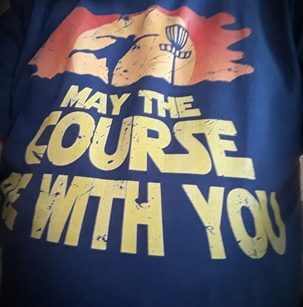
So, do dancing monks retire? Do I as a dancing monk retire from the disciplines and practices of our calling? The landscape of my being a monk has changed. For the present I’ve retreated from attending weekly church gatherings, except for the occasional participation in a streamed service from Washington National Cathedral or daily prayer from Durham Cathedral. The landscape has changed, I am no longer responsible for leading daily or weekly services. Personal sabbath is now an everyday occurrence, which it should always be anyway, and the old man and his disk keep walking and throwing the disk as it sails into the wind of the Great Spirit that blows where it will. Dancing monks do not retire but use the fertile ground of retirement to be refreshed and to contribute to the continued emergence of the Beloved Community. As my disc golf shirt says: “May the course be with you.”
[image error]Robert Walk is an American Baptist clergy person in retirement with his wife, Kathleen and their two cats Jack and Jill. He lives in Simpson House Retirement Community in Philadelphia, Pennsylvania where he recently retired after twenty-one years of serving as the Chaplain there.
The post Monk in the World Guest Post: Robert Walk appeared first on Abbey of the Arts.
October 16, 2021
Monk in the World Video Podcasts (Community) ~ A Love Note from Your Online Abbess
Dearest monks, artists, and pilgrims,
We continue our exploration of the Monk in the World Prayer Cycle Video Podcasts with morning and evening prayer for Day 3: Community. The reflection below comes from my new book Breath Prayer: An Ancient Practice for the Everyday Sacred which was released in the US and Canada on Oct 12th.
I see you with love
gifted, cherished.
Grateful
for who you are.
How often do we really see another person as the beautiful gift they are? Perhaps this happens sometimes with those we love, where we are caught in a moment of grace and see them in all their wondrousness and you feel full of gratitude for their presence in your life.
Maybe you have a moment where your eyes meet and you hold each other’s gaze for a few breaths as an act of seeing each other with love.
When I work with individuals in spiritual direction, I actively try to see them through God’s eyes and knowing how deeply loved they are. I try to bring that loving presence into our time together.
We can intentionally bring this gaze of love to others. You can practice this with a beloved one or very dear and close friend. You might try setting a timer for one minute and just sit together, eyes softly receiving each other while breathing together and praying quietly in our hearts.
Breathe in: I see you with love
Breathe out:gifted, cherished.
Breathe in: Grateful
Breathe out:for who you are.
This can be a very intimate and vulnerable moment because we so rarely spend this kind of time simply looking at another person with love and care.
We can also bring this practice out into the world. How often do we really see another person beneath their role, under our expectations? What if we paused at the grocery store and for a moment brought eyes of love to the stock clerk or the cashier. They don’t have to know what you’re doing. You don’t have to stare, just take in their image, then close your eyes for a moment, breathe, and bathe them with love. Pause and see the other person as beloved and beautiful as they indeed truly are.
We do not want to violate their personal space by holding an uncomfortable gaze, but we can have an encounter with them and then pause afterward to hold them with love in our imagination while repeating the breath prayer through a few times.
This can be such a beautiful way to really start to see people who are often invisible to us. We can see them as gifts to the world. We can cultivate a deeper kindness within ourselves too as we begin to widen our appreciation for others.
Join us for the virtual Breath Prayer book launch on Monday, October 25th. We are also offering an Advent Companion retreat to the book.
With great and growing love,
ChristineChristine Valters Paintner, PhD REACE
The post Monk in the World Video Podcasts (Community) ~ A Love Note from Your Online Abbess appeared first on Abbey of the Arts.
October 12, 2021
Monk in the World Guest Post: Kristine Schnarr
I am delighted to share another beautiful submission to the Monk in the World guest post series from the community. Read on for Kristine Schnarr’s reflection on the labyrinth.
[image error]During the majority of my 71 years on this beautiful earth, I have lived in the suburbs of various sprawling cities around the United States. However, born in Chicago, I am very much a city-girl at heart. I am also very much an introvert and very much a contemplative. Over the years, I have always gravitated towards places and spaces, that offer opportunities for quiet prayer and contemplation in the midst of the hustle and bustle of life.
I actually do not remember my very first labyrinth experience. I’m not sure where or when it was. If I had to guess, I would say maybe 25 years ago at a women’s retreat somewhere. Conversely, I will never forget the first time I met My Labyrinth. My Labyrinth and I met the first week of March, 2014. That was the week my husband and I made a big move from a large home with a large yard in a midwestern suburb to a rather smallish condo with a small balcony in the urban setting of Arlington, VA.
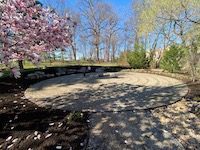
On one of our first walks around our new, vibrant, city neighborhood I spotted a small grassy park-like space less than ¼ mile from our condo. As we ventured into that space, I saw My Labyrinth. It was in a low area, rather hidden from those coming and going on the adjacent city sidewalk and street. It was surrounded by big, beautiful trees that helped create a cathedral effect. It was love at first sight.
You might be wondering why or how I feel I can call this public labyrinth, My Labyrinth. After being in relationship with it for the past 7+ years, I would say that the main reason is I am one of the few people I know who knows about it and who uses it. I hardly ever see anyone else there. When I talk about it or share photos of it with my friends, they always ask its location and then say they have never been there. Even though I am more than happy to share it with others, I rarely see anyone else there. When I do see other people there, I am happy for them, and actually feel a sense of kinship with them. Especially during this unprecedented year of the world-wide COVID pandemic.
[image error]As I traversed the trials and tribulations of these trying pandemic times, I often turned to My beloved Labyrinth for a sense of groundedness, solace and hope. In this place, I truly felt that I could be a Monk in our anguished world. In the face of endless uncertainties, this small space in my urban corner of the world held a spaciousness for me. Here the pandemic paradoxes of sorrow & joy, grief & gratitude or hopelessness & hope could reside together in my heart & soul. Here I prayed. Here grace flowed.
Thomas Merton once said, “In a world of noise, confusion and conflict, it is necessary that there is a place of inner silence and peace, not the peace of mere relaxation but the peace of inner clarity and love.” When I walked My Labyrinth during this tragic year, I was able to abide in that place of inner silence, clarity and love thanks to My Labyrinth. Walking My Labyrinth taught me that if I just kept putting one foot in front of the other and just kept trusting the path I was on, I would reach the center, rest and then be able to continue the journey out into the world with the strength I needed for whatever was ahead. As I walked My Labyrinth’s path, I was given the grace to let go, the faith to trust, the hope to keep going and great gratitude for the beauty and nurture of nature.
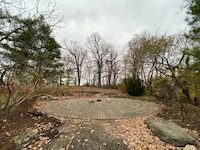
I close with a Haiku poem and a prayer of thanks for My Labyrinth:
OFF THE BEATEN PATH…. MY URBAN LABYRINTH CALLS…INVITING ME IN
Thank you, Holy One, for the gifts of grace you offer to those who seek and love You. Thank you for the gift of My Labyrinth for such a time as this. Thank you for how My Labyrinth has been such a sweet help to me during this challenging pandemic year and how it has nurtured me as I travelled the way of being a Monk in the World.

Kristine Schnarr and her husband, Mark, live in Arlington, VA. Kristine thanks Abbey of the Arts for nurturing her interest in Celtic Spirituality and her love for contemplative spiritual practices. Kristine is an avid, amateur contemplative photographer. She loves to share and give away her photos to others and use them to inspire her recent love for writing Haiku poems.
The post Monk in the World Guest Post: Kristine Schnarr appeared first on Abbey of the Arts.
Monk in the World Video Podcasts (Hospitality) + Breath Prayer ~ A Love Note from Your Online Abbess
Dearest monks, artists, and pilgrims,
We continue our exploration of the Monk in the World Prayer Cycle Video Podcasts with morning and evening prayer for Day 2: Hospitality. Hospitality invites us to welcome the stranger both within and without. The ancient practice of breath prayer is a lovely way to engage with the principle of hospitality. The reflection below comes from my new book Breath Prayer: An Ancient Practice for the Everyday Sacred to be released in the US and Canada on Oct 12th.
I surrender the ache,
and the worry.
Breathe in stillness,
breathe out anxiety.
Monks used to awaken in the middle of the night intentionally to pray Vigils. Some of the stricter monastic orders, like Trappist, still do. It is a way of consecrating all the Hours of the day, including the dark of the night.
If our sleep patterns get disrupted and we awaken sometime in those early hours before the sun rises, we might consider joining those monks in our imaginations. Rather than get hooked into the anxiety of our churning thoughts, this opening to the night can be an opportunity to savor stillness, to rest into the unknown, to breathe love out to a hurting world, to bathe our communities in prayers for peace, and to allow our breathing to soften our hold on things so that we might slowly release ourselves back into slumber.
I know for myself the worst anxiety can come when I have to be somewhere the next day, perhaps teaching in the morning, and I start to worry whether I will get enough rest. This worry, of course interferes with the possibility of going back to sleep and can become a vicious cycle.
Sometimes I sit up and read for a while or write down what my mind is grasping for. But mostly breath and prayer are the balm that help to calm and soothe me. They help to sanctify these moments when I would prefer to be asleep. They become opportunities for prayer and connection with Source. I see myself joining with monks around the world awake at that very same moment offering their prayers of praise and gratitude.
Breathe in: I surrender the ache;
Breathe out: and the worry.
Breathe in: Breathe in stillness,
Breathe out: breathe out anxiety.
Similar to the breath prayer at bedtime, this breath prayer is about allowing our body to surrender and yield, to release anxiety and worry as much as possible, and let the darkness comfort and hold us for a while. This time of night wakefulness can be a practice in learning to appreciate mystery. So much of the anxiety arises from the parts of ourselves that want to plan and control and know the outcome of things. Of course, none of us knows these things and life is largely out of our control, especially with the larger events we experience.
In the first part of the breath prayer, see if you can physically allow your body to surrender anything it is holding onto. Sometimes taking an extra deep breath and letting it out with a long sigh can really help with this release.
In the second part of the breath prayer, notice what breathing in stillness and breathing out anxiety feel like for you. See what colors or sensations are present. If it is helpful to pray with images, visualize your inhale drawing in this gift of stillness. Visualize your exhale letting go of any anxiety or worry.
In his poem “Sweet Darkness,” David Whyte writes “The night will give you a horizon / further than you can see.” Many of us aren’t used to spending time with ourselves and when we slow down and let go of the many possible distractions we are left with our mind’s churning. Breath prayer helps us to ease the racing thoughts by giving our mind another focus and direction. We can bring an intention of restfulness and release to our nighttime hours though this practice. The words give us an intention so we might find more ease in these middle-of-the-night awakenings.
I also have an article on breath prayer published in US Catholic. Join us for the virtual Breath Prayer book launch on Monday, October 25th.
With great and growing love,
ChristineChristine Valters Paintner, PhD REACE
The post Monk in the World Video Podcasts (Hospitality) + Breath Prayer ~ A Love Note from Your Online Abbess appeared first on Abbey of the Arts.
October 5, 2021
Monk in the World Guest Post: Kate Kennington Steer
I am delighted to share another beautiful submission to the Monk in the World guest post series from the community. Read on for Kate Kennington Steer’s reflection on the richness of photography within a contemplative cell.
As a contemplative photographer I thought I knew quite a bit about light and brightness, shadow and darkness. It appears I was wrong. During 2020 and 2021 a series of COVID-19 ‘Lockdowns’ have been offering me a unique opportunity to maintain a watch on the seasonal cycles of light across my bedroom walls. I have wanted to do this ever since, back in 2013-4, our online Abbess Christine [Valters-Paintner] introduced me to the Celtic rituals surrounding the ‘cross-quarter days’ which divide the weeks between the seasonal equinoxes and solstices. And so, from Beltaine 2020 (1 May) to Beltaine 2021, I have watched and marked, photographed and written about how light changes what and how I see; how watching light changes the light in me.
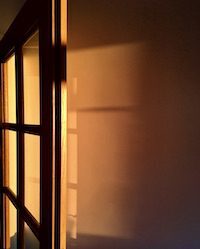
Yet, as we all know, 2020-21 has been a deeply odd year (to put it mildly). I have spent the vast majority of the year shielding with my parents, and as someone who struggles with chronic illness, I have spent most of it living a predominantly bed-based life. So there has been little seasonal variation in my habits and virtually no seasonal variation in the state of my health. The constant tussle I have with clinical depression has continued, as have the seizure symptoms of the Functional Neurological Disorder I live with. I have left the house only a handful of times, with trips to the doctor and hospital predominating. So I’ve not seen much of the outside world.
But then, over the last year, unless we have been a precious key-worker undergoing the relentless pressure of a physically and emotionally demanding workload, haven’t the vast majority of us seen more of the inside walls of our homes than we would normally? Whether we’ve welcomed it or hated it, this period has brought a step-change of pace, with all the attendant anxieties that such changes might pose. There are as many ways as there are reasons by which minute seasonal changes of light might have continued to pass me by in the last year, but by grace I was able to continue the long, slow, frustrating art of learning to detach myself enough from the zeitgeist of communal anxiety creeping under my bedroom door with every news bulletin; to put a brake on the hamster-wheel of my own pain-filled preoccupations; and stop long enough to look, record, remember and dream about how I feel about light in every time and season.
This fresh appreciation for the direction and intensity of light falling across the walls and windows of the room I stay in at my parents’ house is encouraging me to finish the book I have been writing since the winter of 2014/15. That year, with the help of a couple of the Abbey’s online retreats, I discovered a framework that helped me put years of chronic illness into a more present perspective. I have been exploring this ever since, in one way or another, on my blogs shot at ten paces and image into ikon, and my book Walls, Wounds and Wonders will be the result of extended reflection in word and image on a fourth-century monastic encounter in the Egyptian desert:
A brother came to Scetis to visit Abba Moses and asked him “ Father, give me a word.” The old man said to him “ Go, sit in your cell, and your cell will teach you everything.”
Over the course of the last seven years I have spent months based in bed in one room, and I realised there was an opportunity here: what did these walls, in this ‘cell’, have to teach me?

The resulting richness has meant I have a very long first draft to edit, but the abundance this extended gratitude practice continues to bring me is beyond comprehension or explanation. I have realised these walls are pure Gift, pure Grace.
For example, these walls have provided a Sanctuary, where I can rest under large windows which have become battened-down prayers against cold winds, or thrown-open rejoicings as I listen to buzzards circle the thermals by day and owls haunt the fields by night. They have provided a Library, a hushed space where I can study, read and write when concentration allows. They have provided a Refectory, where friends can pull up a chair beside my bed and we can share a pot of tea, laugh and weep together. They have provided a Studio on the days I can sit upright and doodle with watercolour paints, pens and pencils, or collage ripped-up bits of paper. And they have provided me with a Light-Laboratory, so that on days where my vision can bear it, I can grab my iPhone and experiment, waiting to receive an image I might make part of my Facebook project acts of daily seeing.
Learning that everything which could possibly be vital for my flourishing is encapsulated within one room is such a humbling lesson. It is one I have to relearn at least once daily, particularly when the urge to accumulate, to hoard, to click and consume books or art materials overcomes me. This year’s focus of attention on the infinite variety that is light, has begun to train me to seek the antidote to such self-centredness in sky-watching, whenever my vision allows and wherever possible; breathing deeply, basking in the glory and the grace freely given for our delight and inspiration; offering up my inadequate songs of thanksgiving in response.

Kate Kennington Steer is a writer, photographer and visual artist with a passion for exploring contemplative spirituality through the expressive arts. She writes about these things on her shot at ten paces and image into ikon blogs. Join in her visual conversations on the Acts of Daily Seeing Facebook page, or follow her on Instagram. All images by Kate Kennington Steer
The post Monk in the World Guest Post: Kate Kennington Steer appeared first on Abbey of the Arts.
September 28, 2021
Monk in the World Guest Post: Pat Slentz
I am delighted to share another beautiful submission to the Monk in the World guest post series from the community. Read on for Pat Slentz’s reflection and poem “Touchdown into a Silence.”
I greatly appreciate the joy and perspective that living in the mountains brings me. For me, the mountains are the perfect metaphor for the up and down struggles we face in our pilgrimage through this life. The sounds and sights of mountaintops and valleys both open me to the expanse of God’s love and creation and strengthen my connection to Spirit. Photographing the beauty of Colorado on long walks with my husband has been a daily contemplative practice that has brought me relief, inspiration and renewal, especially during this past year of the pandemic. I recently found inspiration from poet Joy Harjo’s opening lines of her lovely “Eagle Poem”: “To pray you open your whole self/To sky, to earth, to sun, to moon/To one whole voice that is you.” I feel very blessed to experience such gratitude for the beauty around us that continues to overshadow the darkness so prevalent in our world.

Touchdown into a Silence
(Inspired by Joy Harjo’s “Eagle Poem”)
As the soft gargle of winter’s winding river calms
my inner chatter, I begin to hear a tiny orchestra warming up –
blue tit piccolo, Downey’s staccato percussion,
plaintive cry of red-breasted Nuthatch, a distant oboe –
silence is not always still.
A flicker’s shrill wake-up call halts my walk
calling me to absorb his anxiety, notice his delicate beauty.
Ducks in tuxedos dive deep, then pop up unexpectedly
across Jayhawker pond. One never knows
where the ripples end when you let go of formalities.
Last Saturday in Barr Lake’s rookery
I saw momma eagle’s white head
peering out above huge nest,
while father stood patiently on lake’s ice
like the fishermen I’ve seen drilling holes
to sink their lines of hope.
I can’t help smiling when I witness a goose couple
strolling on the ice, one giving the other advice.
Other geese fly in, honking like subcompacts
in an Italian round-a-bout, a fluctuating formation
circling downward, wings extended,
their bodies suddenly jerk upright,
skidding, spraying, brakeless as sea planes,
colliding to an abrupt stop on river’s surface.
No responsibilities – just carefree splashing
in melting river, great wings flapping, reminding me
of undiapered children in a summer pool.
As I’ve journeyed through this long pandemic,
I grieve how little remains the same.
On high red cliffs over Watson Lake
the massive eagle’s nest sadly sits empty
and abandoned nests along the north shore of Boyd Lake
contain no gray owl fluff this spring.
To pray I must open my whole self to what is now.
Can I truly listen to the unheard silence,
play freely like the birds, willing to let go of control,
content not to be so darn certain about things?
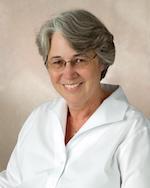
Pat Slentz enjoys a quiet but full life as a spiritual director and labyrinth facilitator in Fort Collins, CO, where she retired in 2016 after working as a UCC Commissioned Minister, hospice chaplain and hospital chaplain in northern New Mexico.
The post Monk in the World Guest Post: Pat Slentz appeared first on Abbey of the Arts.



